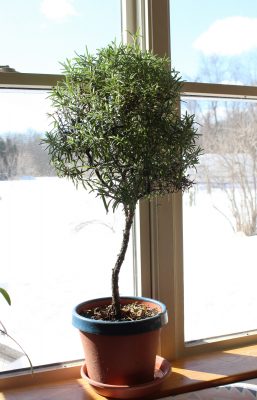Spring Inspires
Even Bob Got the Bug
As I write, daily high temperatures are in the 30s and snow is predicted. Nonetheless, just a few warm, sunny days and almost everyone is going to be inspired to garden. Or at least do something plantwise. Even my friend Bob.
Bob’s non-interest in gardening was demonstrated decades ago as I was starting my first very own garden at a house I was renting. Bob was there as I pushed my shovel into the clay soil of the lawn to turn over spadeful after spadeful. Bob watched peacefully lying beyond the proposed plot with his head propped up on his hands. (Not so another friend, Hans, who grabbed another shovel, and dug. Now that I think of it, perhaps I owned only two shovels.)
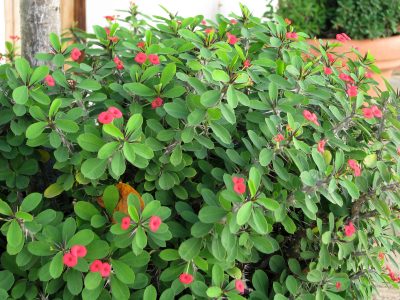
A crown of thorns (not Bob’s)
Bob’s current interest centers around one plant, a potted crown of thorns plant (Euphorbia milii). Crown of thorns is very easy to grow because it’s a succulent. Like other succulents, crown of thorns can store water, in this case in both its thick stems and its fleshy leaves.
The stems, armed with stout thorns, are what give crown of thorns its common name. Legend has it that this plant was woven into the crown of thorns worn by Jesus. Although the plant is native to Madagascar, it had made its way to the Middle East by the time of Christ. But it probably was not the plant that made his crown of thorns.
I once had a crown of thorns plant, and, unlike Bob, with his plant, pretty much ignored it as far as care. Mine flowered occasionally, which was enough because I had a lot of other plants to entertain me. Bob, on the other hand, is becoming a crown of thorns maven, tweaking conditions to try to eke the most and best blooms from his one plant. We go back and forth on how much light they need (the more the better) and how frequently to water (I suggest infrequent but deep watering). The final word has not been said.
Differences of opinion may be traced to differences of plants. Crown of thorns became a popular plant in the 1970s and new varieties were being offered, among them hybrids between E. milii and E. lophogona. The latter species have long, leathery leaves and flower more freely than the former. Some varieties of these hybrids had stouter stems and thinner leaves; others had thinner stems and thicker leaves. Flower sizes increased and a range of shades, from white to pink to red, became available.
Not all hybrid crown of thorns plants enjoy the same growing conditions. Some of the hybrids prefer their soil consistently moist rather than cycling between bone dry and wet. More light is generally better for more flowers although some plants need long nights without any light at all for best flowering.
In a few weeks Bob is going to prune his plant so I’ll get a few cuttings to make plants of my own. The cuttings root in a month or two if their cut ends are dipped in cold water to prevent excess loss of the white sap, slid into a well drained mix, such as peat and perlite, and kept slightly moist.
Horticultural Evolution
So Bob has horticulturally evolved to lavish care on his one plant. He’s busy repotting it this time of year.
I’ve also horticulturally evolved. I would no longer begin a garden by turning over shovelful after shovelful of soil. Nowadays my method is to smother lawn grass beneath wetted paper topped with compost for planting areas and wood chips for paths, which avoids two problems with that first planting: having to wait a couple of weeks before planting, and then having to deal with the sea of quack grass and other weeds that result from turning over the soil. More details on this in my book Weedless Gardening.

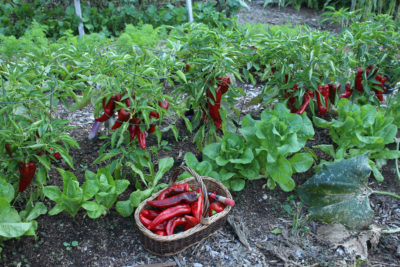
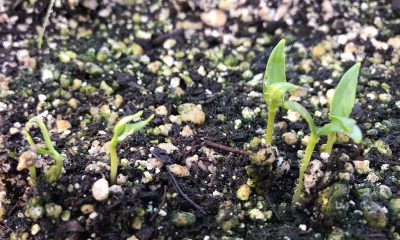
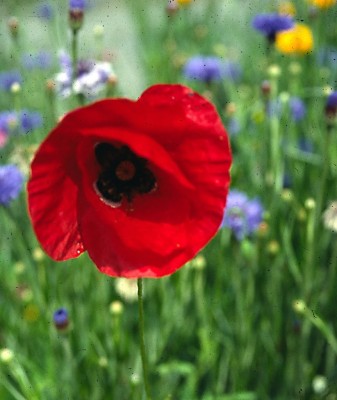
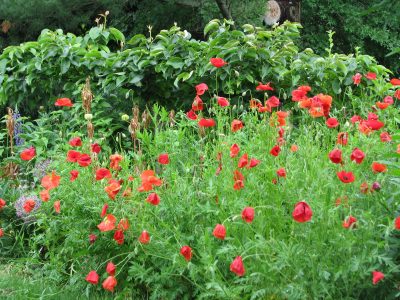
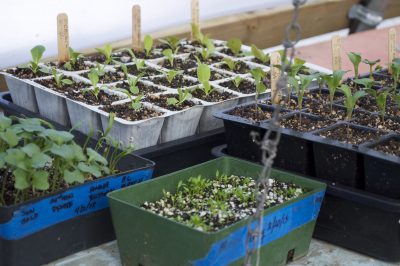 An exhaust fan keeps temperatures from getting too high, which, with lows in the 30s, would wreak havoc with plant growth, at the very least causing lettuce, mustard, and arugula to go to seed and lose quality too soon.
An exhaust fan keeps temperatures from getting too high, which, with lows in the 30s, would wreak havoc with plant growth, at the very least causing lettuce, mustard, and arugula to go to seed and lose quality too soon.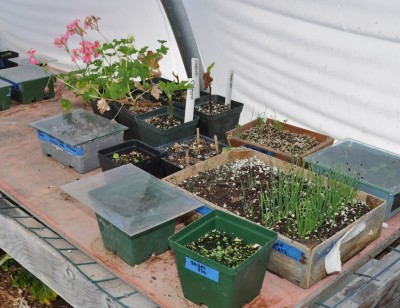
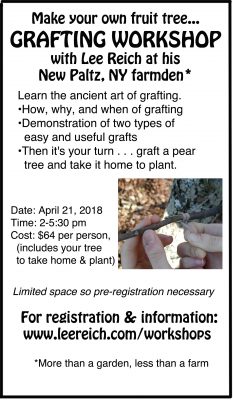
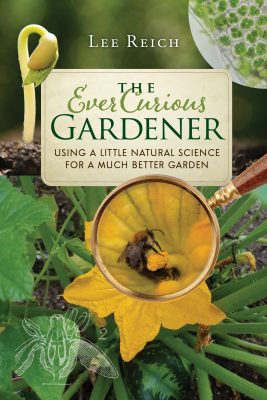 This book grew out of my long love affair with gardening—such a congenial confluence of colors, flavors, and aromas all seasoned with the weather, whatever pests happen to stop by that year—and the science behind it all!
This book grew out of my long love affair with gardening—such a congenial confluence of colors, flavors, and aromas all seasoned with the weather, whatever pests happen to stop by that year—and the science behind it all!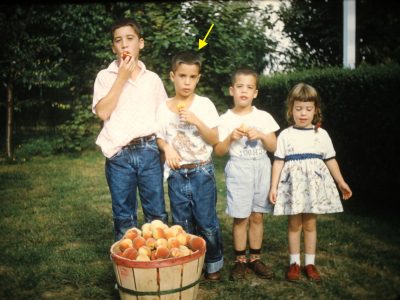 Wait! How about that potted banana tree and one hyacinth bulb that I nurtured under the purple glow of a Growlite in the basement during high school? Or the potted cactus that I bought to adorn my bedroom windowsill in graduate school. Hints of future interest? Perhaps.
Wait! How about that potted banana tree and one hyacinth bulb that I nurtured under the purple glow of a Growlite in the basement during high school? Or the potted cactus that I bought to adorn my bedroom windowsill in graduate school. Hints of future interest? Perhaps.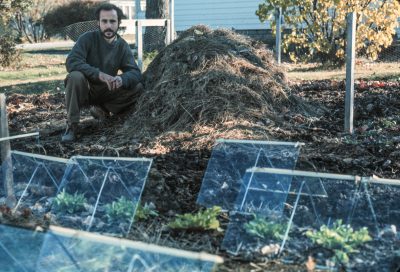 The university’s agricultural library offered more books to further round out my education. (I remember coming across a whole book on lettuce seed!)
The university’s agricultural library offered more books to further round out my education. (I remember coming across a whole book on lettuce seed!)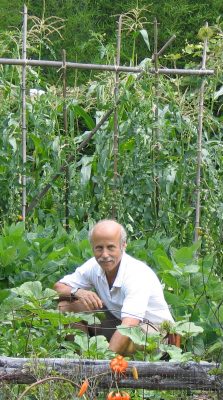
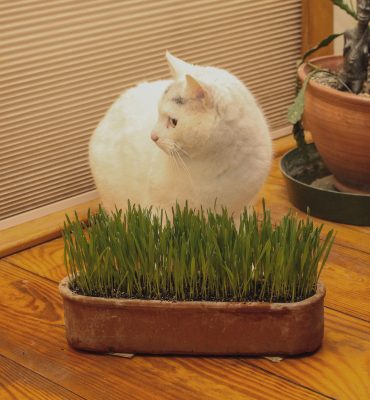
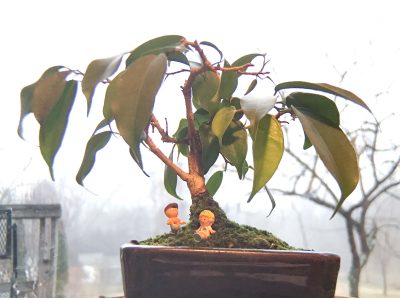 Moss carpeting the soil beneath it and creeping up the trunk complete the picture. I’ve made and am making baby ficus into a bonsai.
Moss carpeting the soil beneath it and creeping up the trunk complete the picture. I’ve made and am making baby ficus into a bonsai.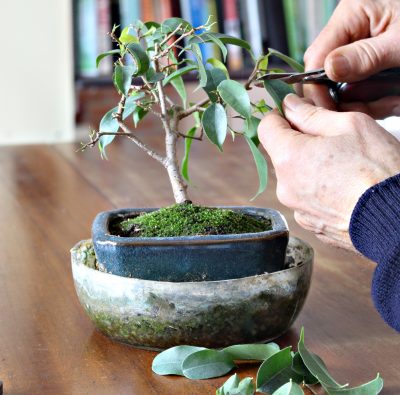 Clipping the leaves accomplishes two goals. First, plants lose water through their leaves so removing leaves reduces water loss (important in consideration of the next celebratory step).
Clipping the leaves accomplishes two goals. First, plants lose water through their leaves so removing leaves reduces water loss (important in consideration of the next celebratory step).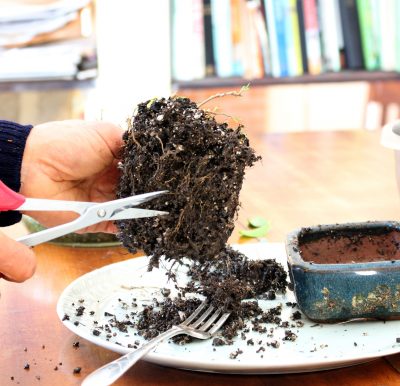 Baby ficus gets all water and its nourishment from this amount of soil. Within 6 months or so, roots thoroughly fill the pot of soil and have extracted much of the nourishment contained within.
Baby ficus gets all water and its nourishment from this amount of soil. Within 6 months or so, roots thoroughly fill the pot of soil and have extracted much of the nourishment contained within.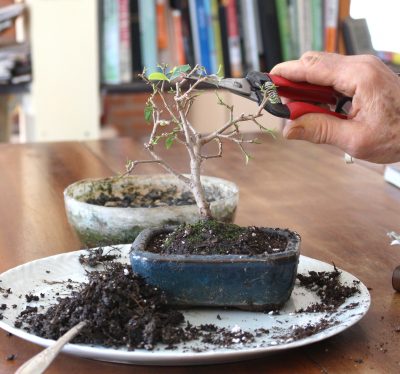 As far as science, I shorten stems where I want branching, usually just below the cut. Where I don’t want branching but want to decongest stems, I remove a stem or stems right to their base. I also remove any broken, dead, or crossing branches unless, of course, leaving them would be picturesque.
As far as science, I shorten stems where I want branching, usually just below the cut. Where I don’t want branching but want to decongest stems, I remove a stem or stems right to their base. I also remove any broken, dead, or crossing branches unless, of course, leaving them would be picturesque.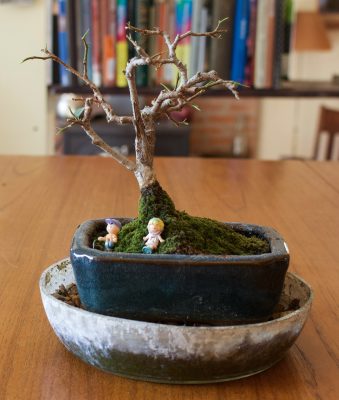
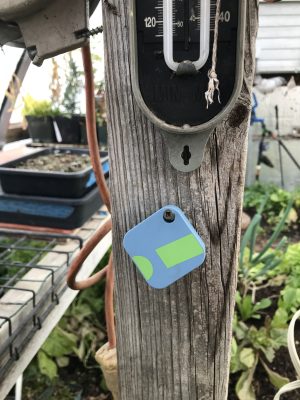
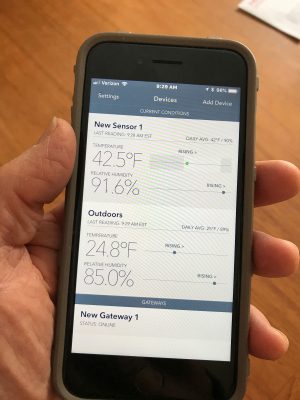 The Gateway connects via wi-fi to put the temperature and humidity information on the web and then on to my smartphone. From anywhere that I have cell service.
The Gateway connects via wi-fi to put the temperature and humidity information on the web and then on to my smartphone. From anywhere that I have cell service. 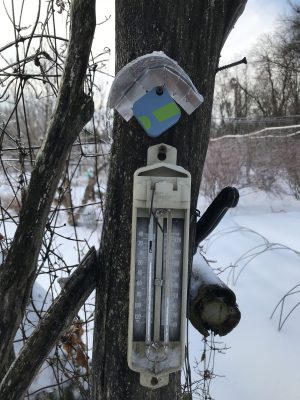 Just how much cold kills these blossoms depends on the kind of fruit and the stage of blossoming. For instance, when apricot flower buds have just begun to swell and separate, they’ll laugh off cold down to zero degrees F. Once the petals begin to spread, the buds are killed at 19°F. When petals fall, 24° is lethal.
Just how much cold kills these blossoms depends on the kind of fruit and the stage of blossoming. For instance, when apricot flower buds have just begun to swell and separate, they’ll laugh off cold down to zero degrees F. Once the petals begin to spread, the buds are killed at 19°F. When petals fall, 24° is lethal.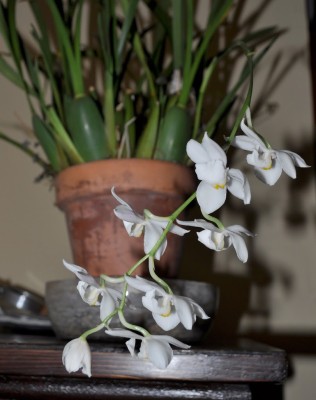 The plant spends summers outdoors in semi-shade near the north wall of my house, and winters indoors on a sunny windowsill. I water it perhaps twice a week, unless I forget.
The plant spends summers outdoors in semi-shade near the north wall of my house, and winters indoors on a sunny windowsill. I water it perhaps twice a week, unless I forget. This orchid is Dendrobium kingianum, which does go under the more user-friendly common name of pink rock orchid. I have also gotten this one to flower — but not every year.
This orchid is Dendrobium kingianum, which does go under the more user-friendly common name of pink rock orchid. I have also gotten this one to flower — but not every year.